

China and Turkey have become Russia's main trading partners since the start of the war, with almost a third of Russia's exports passing through Turkey alone. And while Moscow is now critically dependent on Beijing and Ankara, especially as trade intermediaries, Xi Jinping and Recep Tayyip Erdogan are free to choose their partners — and when faced with choosing between Russia and the West, they are likely to be pragmatic. After all, unlike Russian oil, China has no substitute for Taiwanese microchips.
Content
Guess who we're trading with!
Who depends on whom
Critical dependence on Turkey and China in the equipment and electrical markets
An awkward position
Russia's economic links with Western Europe, the United States and its allies have been largely severed. At the same time, Russia's own productive capacity is insufficient to wage war, develop or maintain normal consumption. Yet the system is not collapsing. All types of spending remain stable: consumption and investment, private and public, peaceful and military.
Developing countries are helping. Most of Russia's conventional exports are now being shipped there, and in return, imports are flowing into Russia. These imports include not only local products, primarily from China, but also transit goods from the developed world. None of this is new. What is remarkable, however, is the extent to which Russia's main trade flows are now concentrated in just two directions. The official line is that by breaking with the West, Russia has strengthened its ties with a “bigger” and “better” part of humanity. In reality, it would be more accurate to say that it has become critically dependent on China and Turkey.
Guess who we're trading with!
It is not easy to analyse Russia's foreign trade now, because the statistical publications of the Federal Customs Service (FCS), which were monthly until January 2022, stopped in April 2022, and partially resumed in March 2023, but not by country. At the time, it was promised that export and import data for different commodity groups would be published monthly. However, there has been no update of the data on the FCS website since then.
The customs service publishes the data unofficially. In January 2023, the FCS told the Vedomosti newspaper that Russia's top five trading partners in 2022 were China, Turkey, the Netherlands, Germany and Belarus. A year earlier, in the peaceful year of 2021, it was China, Germany, the Netherlands, Belarus and the United States. Turkey was sixth at the time. Now it is second only to China.
There are only five directions in which Russia can trade with the outside world. The first, the West, has been mostly (though not entirely) sealed off. The second, Turkey, plays a crucial role in attempts to bypass the EU from the south. Almost all of Russia's economic links with the Middle East, Africa, Latin America and the Indian Ocean, including oil supplies to India, depend on Turkish transit. The third direction — through the south — is of little use because there are no sea routes to the world's oceans, and dry routes ultimately lead to Iran or Afghanistan. The fourth is the Chinese direction — its importance is obvious. And finally, the fifth — across the Pacific Ocean to any ports other than the Chinese ones, from Vietnam all the way to Alaska. This is not very promising. The distances are huge, the infrastructure in the Russian Far East is weak and expensive, and potential partners are either in conflict with Russia or poor.
So what is the specific weight of these destinations in Russian imports? To understand this, we need to look at the mirror statistics of foreign countries trading with Russia, based on at least some public information. Even analysts who are fairly loyal to the Kremlin, or even neutral, are doing this these days. Take the graphs from an article by economist Nikolai Shkolyar on the website of the Russian International Affairs Council.
The Water Truce
The Water Truce is from How Fear Came to the Jungle by Rudyard Kipling in the second Jungle Book. It tells about a drought which brings all the animals to gather at the last remaining pool in the Wainganga River under a 'Water Truce', where the Law of the Jungle forbids anyone from hunting at the river banks.
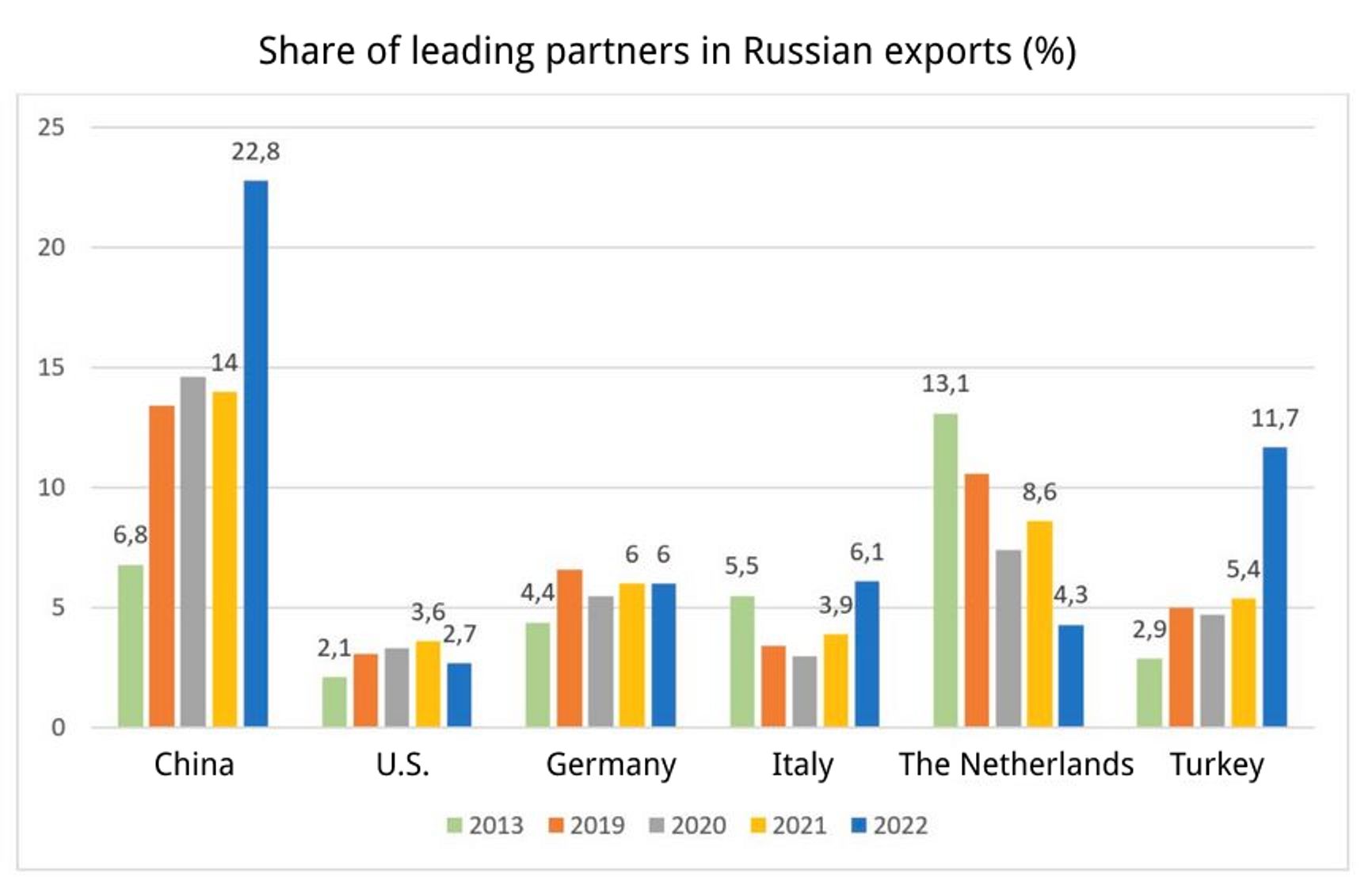
The Water Truce
The Water Truce is from How Fear Came to the Jungle by Rudyard Kipling in the second Jungle Book. It tells about a drought which brings all the animals to gather at the last remaining pool in the Wainganga River under a 'Water Truce', where the Law of the Jungle forbids anyone from hunting at the river banks.
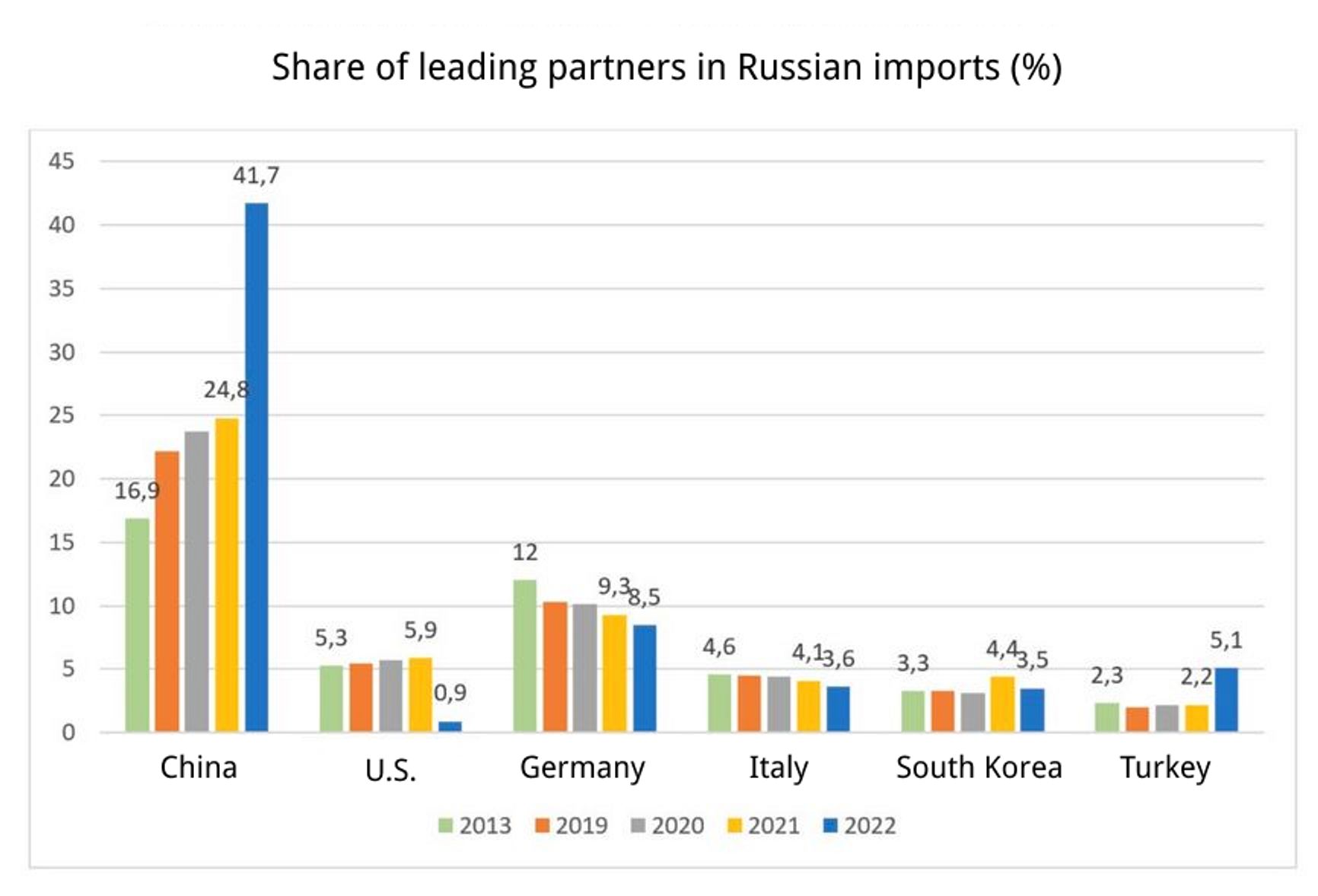
Judging by these figures, China (14%) and the Netherlands (8.6%) were the main importers of Russia’s goods in 2021 — together, they bought less than a quarter (22.6%) of Russian exports. In 2022, the composition has changed: now it is China (22.8%) and Turkey (11.7%), and together they account for more than a third — 34.5%. In other words, the relative concentration of export flows on two key countries can be seen with the naked eye.
If we add the data for 2023 (combining data from the Bank of Russia and mirror statistics from partner countries), we can see the following Exports of goods from Russia in the first half of 2023 will amount to $208 billion. Neither Russian nor Chinese statistics have yet revealed how much of this amount went to China. But it is known that Turkey's contribution was $25 billion, India's was $32 billion and Brazil's was $4 billion. Given that the maritime routes from Russia to India and Brazil pass through Turkey, it turns out that the Turkish direction now accounts for almost 30% of Russia's exported goods.
The Water Truce
The Water Truce is from How Fear Came to the Jungle by Rudyard Kipling in the second Jungle Book. It tells about a drought which brings all the animals to gather at the last remaining pool in the Wainganga River under a 'Water Truce', where the Law of the Jungle forbids anyone from hunting at the river banks.
The Turkish direction accounts for almost 30% of Russia’s exported goods
Let's look at imports into Russia. In 2021, the largest volumes came from China (24.8%) and Germany (9.3%). Together, these two countries accounted for 34.1% of imports. In 2022, China’s share jumped to 41.7%, and Germany’s share, which remained in second place at the end of the year, fell to 8.5%. However, if we look at quarterly rather than annual results, by the fourth quarter of 2022 Germany was importing less to Russia than Turkey, let alone in 2023. In the first half of 2023, according to the Central Bank, Russia's total imports amounted to $151 billion. 3.4% of these imports came from Germany, 3.8% from Turkey, and at least 5-6% from the entire Turkish direction, including transit.
However, these estimates are approximate, as the Central Bank's data do not include a breakdown by country — it had to be taken from foreign mirror statistics, and excluding Chinese statistics, which have not yet appeared.
In 2022, 50.2% of Russia's imports — not a third and a bit, but half — will come from the two countries. In other words, the importance of Russia's largest trading partners is growing. And since there is no reason to expect an increase in supplies from Germany, it is quite possible that by the end of 2023, more than half of Russia's imports will come from China.
Who depends on whom
There is no symmetry at all: for China, imports from Russia accounted for only 4.2% of the total in 2022. Russia is only China's sixth largest supplier. More important to Beijing are partners such as Taiwan (8.8 % of imports), South Korea (7.4 %), Japan (6.8 %), the United States (6.6 %) and Australia (5.2 %). All of these countries are considered “unfriendly” by the Kremlin.
To be fair, the People's Republic of China (PRC) is no friend of the U.S. or any of its allies, including Taiwan. And China's trade with Taiwan, South Korea, Japan, the US and Australia fell in 2022, while trade with Russia rose. Nevertheless, «hostile» Taiwan continues to supply China with twice as many goods as «friendly» Russia. Taiwan also supplies China with advanced microchips. If the Sino-Taiwanese conflict escalates, Beijing will not be able to substitute anything, as it will likely lose access to South Korean, Japanese and American chips. However, it can easily replace Russian oil with supplies from the Asia-Pacific region and the Persian Gulf.
The Water Truce
The Water Truce is from How Fear Came to the Jungle by Rudyard Kipling in the second Jungle Book. It tells about a drought which brings all the animals to gather at the last remaining pool in the Wainganga River under a 'Water Truce', where the Law of the Jungle forbids anyone from hunting at the river banks.
China can easily replace Russian oil with supplies from the Asia-Pacific region and the Persian Gulf
Russia is even less important for China as a market. In 2022, the primary destinations for Chinese exports include the United States (16%), followed by Hong Kong (8%), Japan (5%), South Korea (4.5%), Vietnam (4%), India, the Netherlands, and Germany (3% each). Subsequently, Malaysia, Taiwan, the United Kingdom, Singapore, Australia, Thailand, Mexico, and finally Russia — ranking 16th with a 2.1% share. Meanwhile, China has emerged as the leading market for Russian exports, accounting for 20% in 2022.
The Water Truce
The Water Truce is from How Fear Came to the Jungle by Rudyard Kipling in the second Jungle Book. It tells about a drought which brings all the animals to gather at the last remaining pool in the Wainganga River under a 'Water Truce', where the Law of the Jungle forbids anyone from hunting at the river banks.
Russia's share in Chinese exports is 2.1%
When people talk about Russia having a one-sided economic dependence on China, or when they say its becoming an appendage, they've got a point. The only thing we can add is that this has happened for no good reason. There are no geographical circumstances that could have led to such a dependency: Russia is not Mongolia or Laos. China's economy and technology are not uniquely advanced, but rather average, with GDP per capita and a human development index (HDI) still lower than Russia's.
Maybe the reverse is true for Turkey? Perhaps Russia is more important to Turkey than Turkey is to Russia? That’s not quite the case either. In 2022, Russia was the most important source of imports for Turkey, accounting for 16% of the total. The share is even higher for fuel, metals and especially cereals. And Turkey was only the third source of imports for Russia in 2022, after China and Germany, providing only 5%. But among the countries to which Turkish products are exported, Russia ranks only 8th, with a share of 3.7%, after Germany, the United States, Iraq, the United Kingdom, Italy, Spain and France. And among countries receiving Russian goods, Turkey ranked second, with a share of at least 10% of Russian exports.
The Water Truce
The Water Truce is from How Fear Came to the Jungle by Rudyard Kipling in the second Jungle Book. It tells about a drought which brings all the animals to gather at the last remaining pool in the Wainganga River under a 'Water Truce', where the Law of the Jungle forbids anyone from hunting at the river banks.
In 2022, Russia was the most important source of imports for Turkey, accounting for 16% of the total
In other words, Turkey pays for Russian raw materials with money it receives from Germany for industrial products (including clothing, car parts, electrical cables, etc.). And the Chinese pay for Russian raw materials with dollars from their exports to the US. In a different situation, Russia could trade with Germany and the U.S. directly, but today's diplomacy requires intermediaries.
Critical dependence on Turkey and China in the equipment and electrical markets
The picture becomes even clearer if we look not only at the volume of trade but also at the turnover for specific groups of goods. The most important groups of imported goods for Russia are shown in the table below. We see that five groups make up almost half of imports, both from the Federal Customs Service and from partner country mirror statistics:
The Water Truce
The Water Truce is from How Fear Came to the Jungle by Rudyard Kipling in the second Jungle Book. It tells about a drought which brings all the animals to gather at the last remaining pool in the Wainganga River under a 'Water Truce', where the Law of the Jungle forbids anyone from hunting at the river banks.
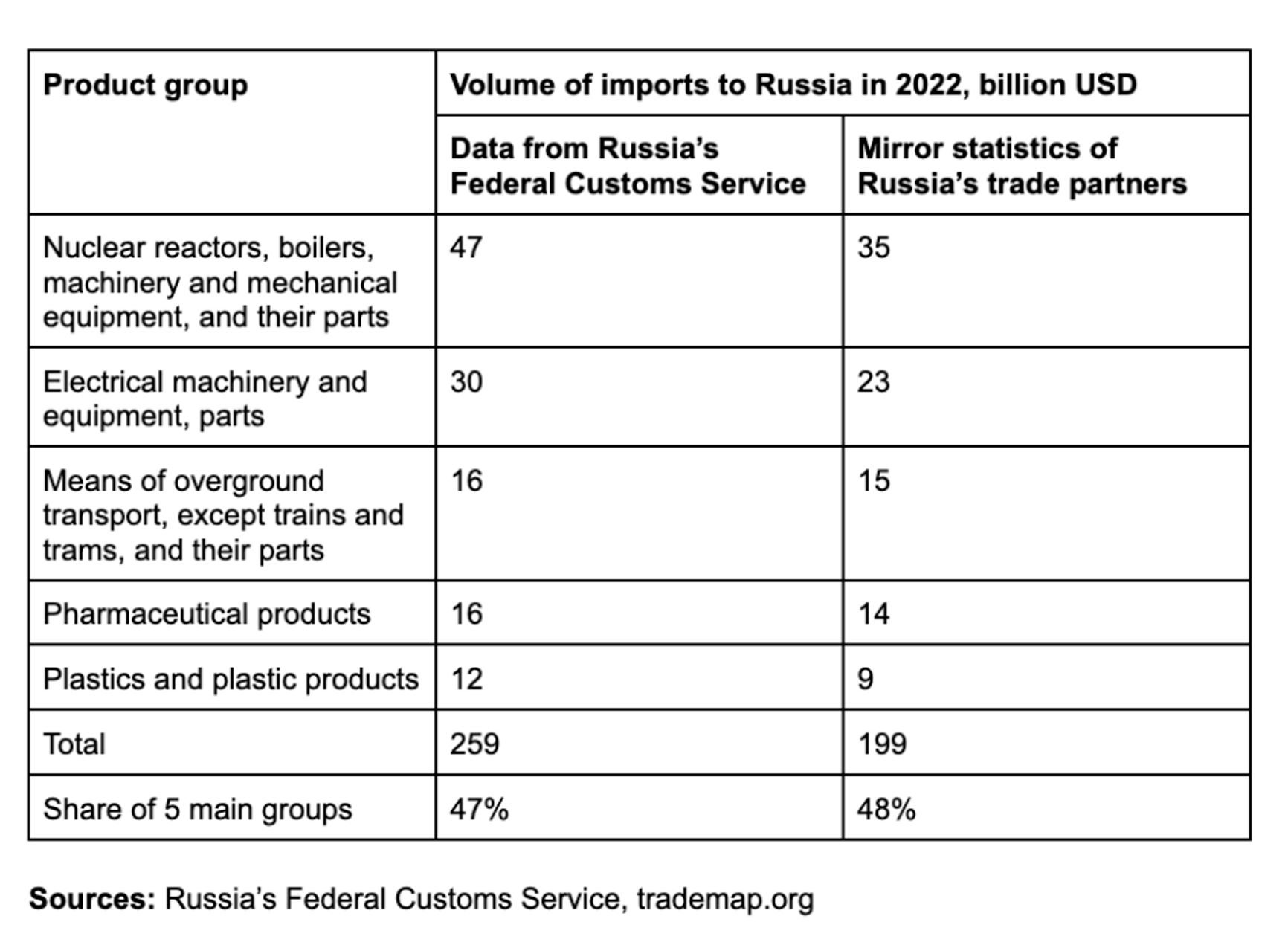
Let's see where the goods of each of these groups come from. Russia’s national statistics won’t be of help here, but we do have mirror data from partner countries.
In the most important category — “Machinery and mechanical equipment” — China directly accounted for 48% of Russian imports in 2022, and if we add Kazakhstan (2.4%, mainly re-exports from China) and Chinese-controlled Hong Kong (2.3%), we get a total of 52.7% of shipments coming from the PRC. The Turkish direction accounted for a further 6.5%, of which 4.6% came from Turkey itself, 1.1% from the UAE and 0.8% from India. Another 6.5%, exclusively at the expense of «unfriendly» countries, came from the Asia-Pacific region: South Korea (3.3%), Japan (2.3%) and Taiwan (0.9%). The remaining 34.3% still came from the West: Germany (8.8%), Italy (5.9%), Poland (2.5%), Finland (1.3%), the Czech Republic (1.3%) and others. Shipments of machinery and equipment to Russia from these countries, however, fell sharply in 2022: deliveries from Germany declined by 59%, Italy (22%), Poland and the Czech Republic (60%), and Finland (52%).
Figures for China for 2023 are not yet available, so it is not possible to calculate the share of different countries in total imports. However, it is known that imports from Germany will continue to decline. In the fourth quarter of 2022, they were already lower than those from Turkey, and since the second quarter of 2023 they have been lower than those from South Korea, which remain at around the pre-war level. There is also a rapid decline in supplies from Poland, Japan and Italy.
The Water Truce
The Water Truce is from How Fear Came to the Jungle by Rudyard Kipling in the second Jungle Book. It tells about a drought which brings all the animals to gather at the last remaining pool in the Wainganga River under a 'Water Truce', where the Law of the Jungle forbids anyone from hunting at the river banks.
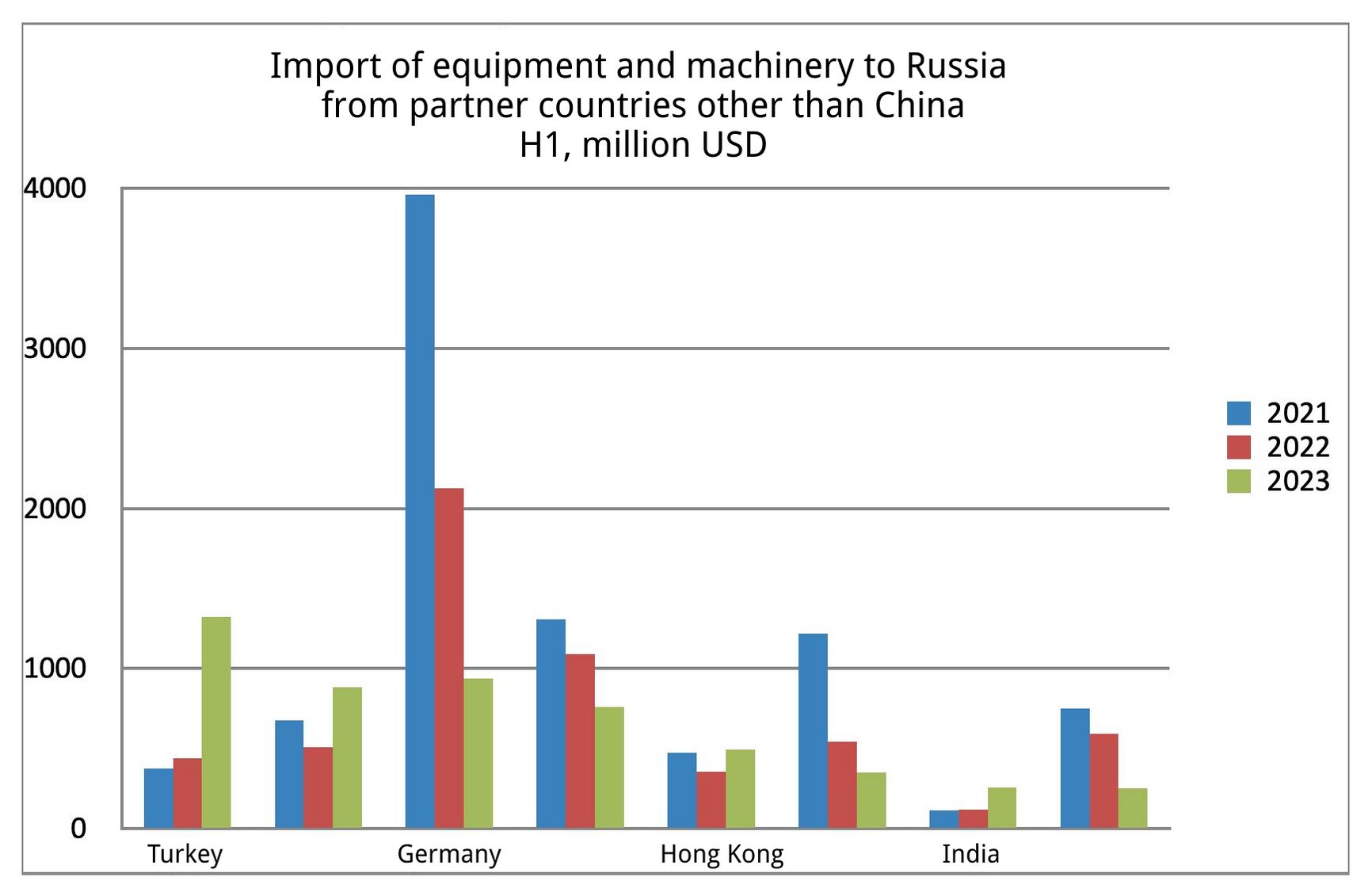
A similar picture emerges for electrical equipment, where Russia's dependence on Chinese and Turkish products is even greater. In 2022, China accounted for 58.2 % of imports in this category, Hong Kong for a further 5.6 % and Kazakhstan for 3.7 %, giving a total of 67.5 % - more than 2/3 - via China. Supplies from the UAE (7.4 %), Turkey itself (2.5 %), India (0.8 %) and Israel (0.6 %) passed through Turkey — a total of 11.3%. Together, China and Turkey accounted for about 79% of the shipments in 2022. Re-exports via Armenia (southbound) accounted for 2.1%. South Korea (1.5%), Taiwan (0.7%) and Vietnam (0.6%) collectively amounted to 2.8% of electrical equipment shipments transiting Asia-Pacific. The remaining 16 % came from the West, with Germany at 3.6%, Poland at 1.5%, Italy at 1.4% and the Netherlands and France both at 0.8%.
In the first half of 2023, western shipments continued their rapid decline, with imports of electrical appliances from South Korea, Taiwan and even India falling, while the importance of transit through Turkey and Armenia rose sharply.
The Water Truce
The Water Truce is from How Fear Came to the Jungle by Rudyard Kipling in the second Jungle Book. It tells about a drought which brings all the animals to gather at the last remaining pool in the Wainganga River under a 'Water Truce', where the Law of the Jungle forbids anyone from hunting at the river banks.
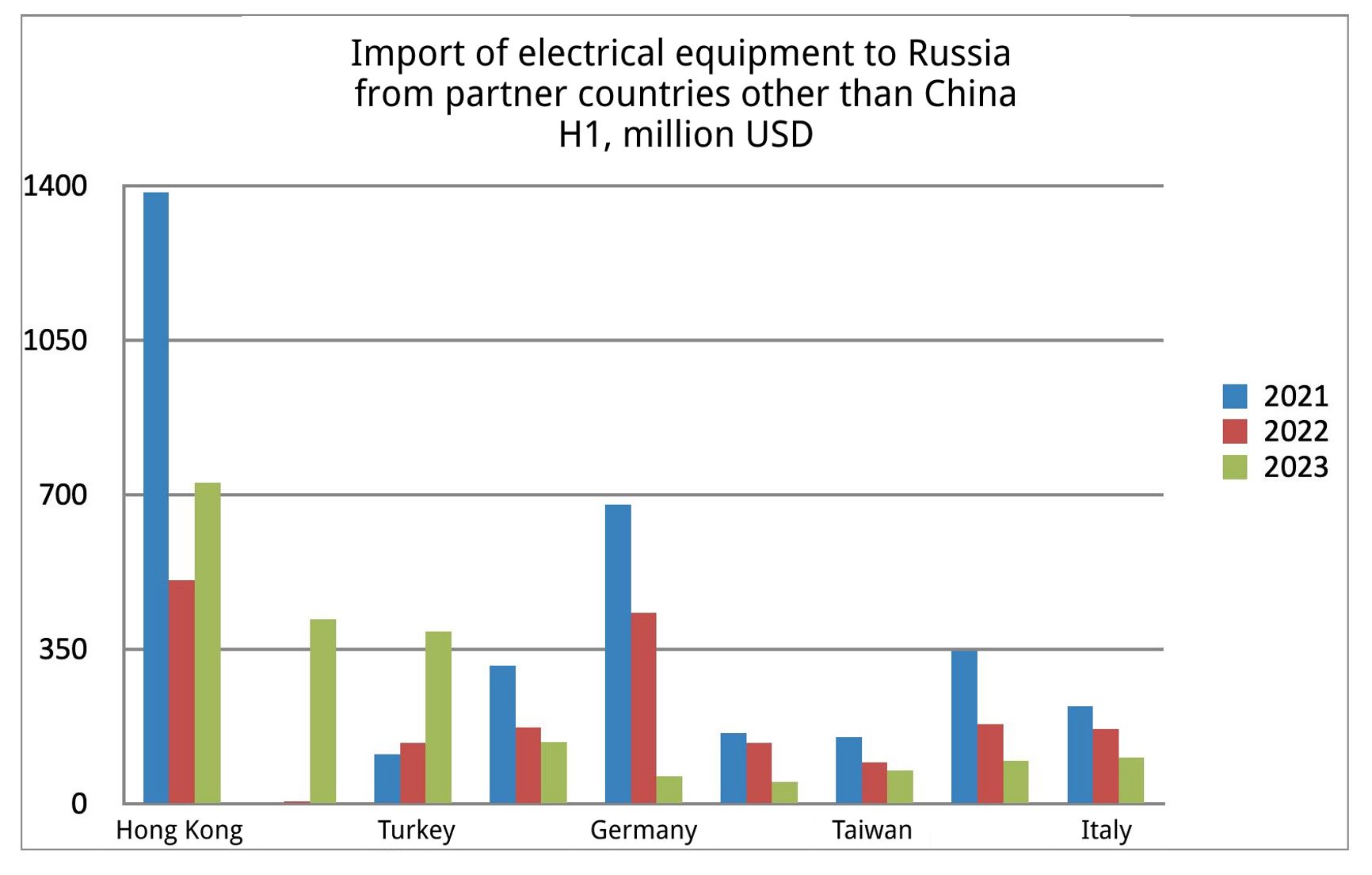
“Means of overground transport, except trains and trams, and their parts” refers to cars and their spare parts. At the end of 2022, supplies from China accounted for 43.3% of all Russian imports under this item. If we add Kazakhstan (1.4%), the Chinese direction accounts for 45%. Not only Turkish supplies (3.3%), but also, strangely enough, Armenian supplies (2%) pass through Turkey. The fact is that cars destined for Russia most often arrive in Armenia via the Georgian port of Poti, and the route there is through the Turkish Bosphorus and the Dardanelles Straits.
In total, 6% of cars entered Russia via Turkey (with a further 1% coming from the United Arab Emirates). 29% arrived via the Pacific route, of which 18% came from Japan and 10% from South Korea. The remaining 20% came from the West (Germany — 7.2%, Poland — 1.4%, USA — 1.3%). It is worth noting that the share of car import deliveries from the West and the developed Pacific countries was still quite high in 2022, although even here half of the total trade flow was already dependent on China and Turkey. By the first half of 2023, Russia was already importing more cars from Turkey and Armenia than from Western Europe. Imports from Germany decreased almost tenfold compared to 2021.
The Water Truce
The Water Truce is from How Fear Came to the Jungle by Rudyard Kipling in the second Jungle Book. It tells about a drought which brings all the animals to gather at the last remaining pool in the Wainganga River under a 'Water Truce', where the Law of the Jungle forbids anyone from hunting at the river banks.

As for pharmaceutical products, the situation is not the same as with other import categories. Here, even in 2022, Russia's western neighbours were still its largest suppliers: Germany (23%), Belgium (15%), Switzerland (14%), the Netherlands (5.9%), Slovenia and Austria (4.7% each). The volume of pharmaceuticals imported from Europe actually continued to increase further. Drug imports from other destinations were insignificant: just over 3% from India, just under 2% from China, and 0.5% from South Korea. Nothing much has changed in 2023: all the top ten countries exporting pharmaceuticals to Russia are in Western Europe. It is telling that the logic of the «water truce» prevails over sanctions and boycotts when it comes to the import of Western European medicines into Russia. Both sides seem to believe that it is still wrong to leave Russian patients without European medicines.
The Water Truce
The Water Truce is from How Fear Came to the Jungle by Rudyard Kipling in the second Jungle Book. It tells about a drought which brings all the animals to gather at the last remaining pool in the Wainganga River under a 'Water Truce', where the Law of the Jungle forbids anyone from hunting at the river banks.

In the “Plastics and Plastic products” group, China's share in 2022 was 42.2%, with a 37% increase in shipments relative to 2021. Germany was in second place with a share of 9.6% and a yearly dynamic of -47% — a two-fold drop. Turkey is in third place with a share of 7.2% and a 2.5-fold year-on-year increase. It is clear that Chinese and Turkish deliveries are fast becoming dominant. However, plastics imported via other routes still remained significant in 2022. South Korea shipped 7.2% of all imported plastic to Russia, 4% came from the southern direction (Azerbaijan, Uzbekistan and Iran) and 35% from the West (apart from Germany, significant volumes came from Poland, Italy and the Netherlands). In 2023, Turkey was the second largest supplier of plastics to Russia after China, while imports from Western Europe and South Korea continued to decline.
The Water Truce
The Water Truce is from How Fear Came to the Jungle by Rudyard Kipling in the second Jungle Book. It tells about a drought which brings all the animals to gather at the last remaining pool in the Wainganga River under a 'Water Truce', where the Law of the Jungle forbids anyone from hunting at the river banks.
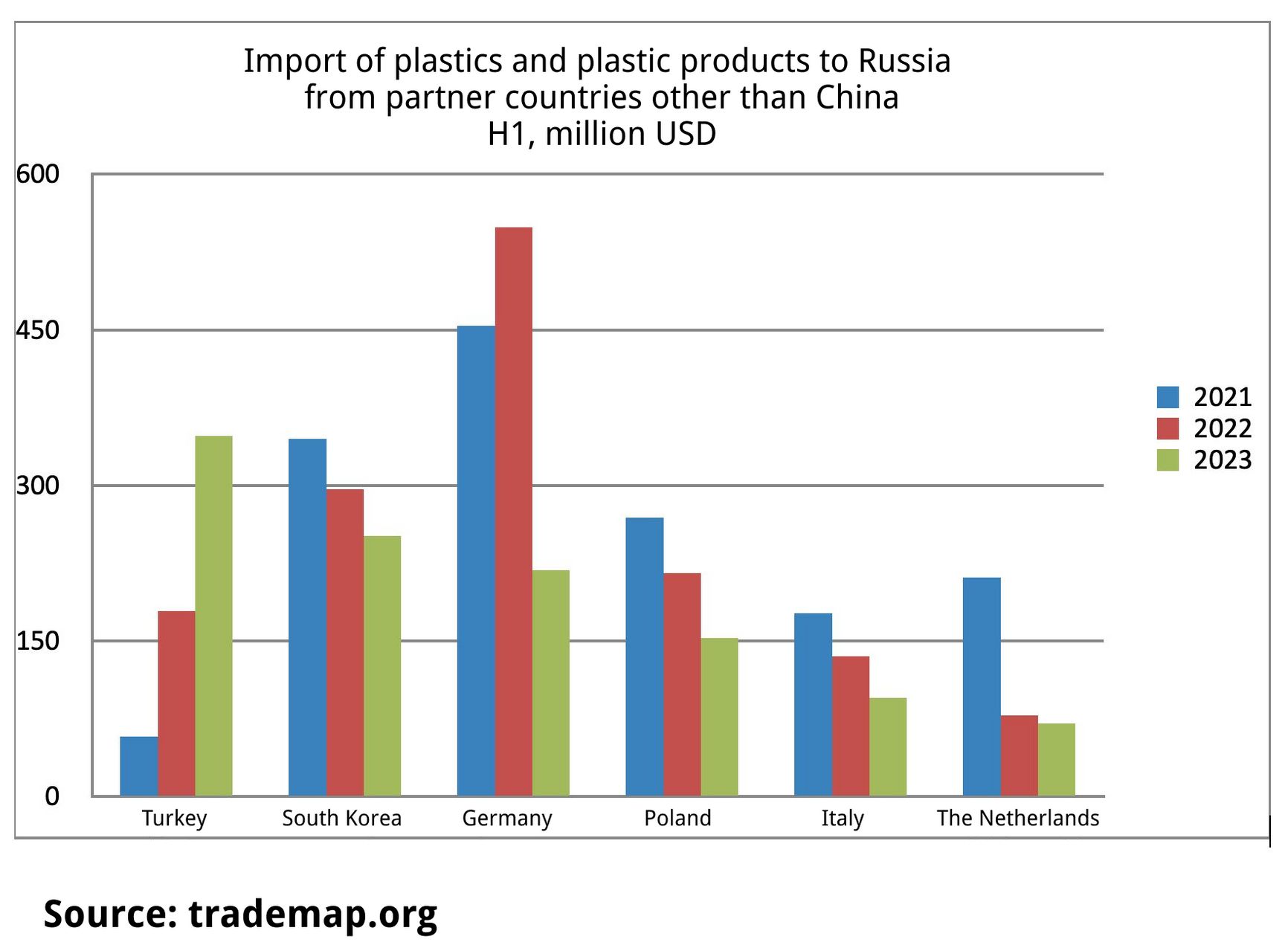
An awkward position
It turns out that Russia's large and growing trade can now be routed through either Turkey or China — both partners are largely needed as intermediaries facilitating the flow of high-tech products from developed countries. Their roles as middlemen in supplying Russia creates uncertainty and ambiguity.
On the one hand, the U.S. can agree to co-operate with them in pressuring the Kremlin, if necessary.
On the other hand, Washington could, in theory, decide that if Xi Jinping and Recep Erdogan value their partnership with Putin so much, then they themselves deserve to face the same sanctions as Putin. Either decision would mean that the mediators would no longer be mediating. They would be willingly or unwillingly joining one side of the conflict, which would then either end quickly or become even more intransigent.
At the same time, Russia is not as important an economic partner for China as the U.S. and its allies, and even Turkey is more dependent on Europe than on Russia. If the leaders of China and Turkey are faced with an either-or situation, pragmatism will tell them to choose their Western partners over Moscow.
The Water Truce
The Water Truce is from How Fear Came to the Jungle by Rudyard Kipling in the second Jungle Book. It tells about a drought which brings all the animals to gather at the last remaining pool in the Wainganga River under a 'Water Truce', where the Law of the Jungle forbids anyone from hunting at the river banks.